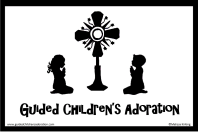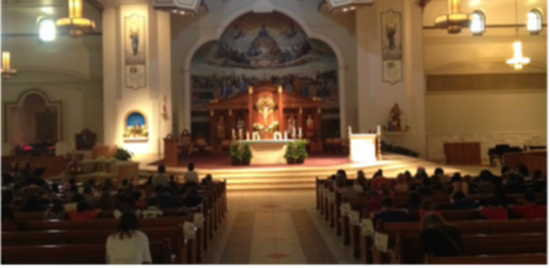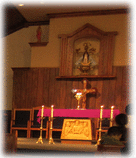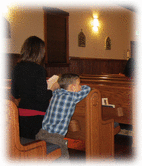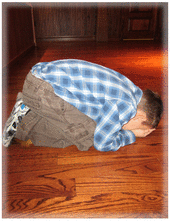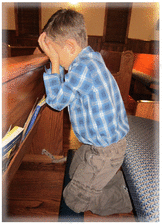|
|
Pointers and Thoughts for
Leading a Guided Children's Adoration
The Plans
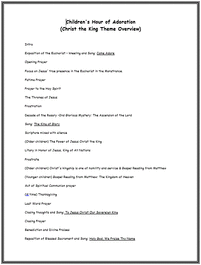
Each session’s plans include an overview sheet, detailed plans of what you will say and when you pause, “extra” prayers, and the booklet with the prayers and some of songs. (Not all the songs’ words are included due to copyright issues, but the choice of song is listed. Please consult your own parish’s rights to use the suggested songs.)
Sometimes you will get through the whole set of plans, sometimes you won’t. There will always be “extra” provided at the end in case you finish early. Each group and each session will vary depending on the age of the children, how long you pause, and where God leads you that particular time. I have done the same session of plans with multiple groups and each time it varies.
There are new prayers and stories with each session’s plans. However, some of the prayers and songs repeat over the sessions so the children become familiar with them. Using some familiar prayers allows the children to pray them with more depth. Also, the children can use these very same prayers in their own prayer time with Jesus outside Adoration.
Sometimes you will get through the whole set of plans, sometimes you won’t. There will always be “extra” provided at the end in case you finish early. Each group and each session will vary depending on the age of the children, how long you pause, and where God leads you that particular time. I have done the same session of plans with multiple groups and each time it varies.
There are new prayers and stories with each session’s plans. However, some of the prayers and songs repeat over the sessions so the children become familiar with them. Using some familiar prayers allows the children to pray them with more depth. Also, the children can use these very same prayers in their own prayer time with Jesus outside Adoration.
The Leader
Practice the plans aloud several times before the Adoration session to allow yourself to speak fluidly and get your timing down.
Come early (30 minutes if possible) to do final preparations and to settle yourself. Pray for the Lord’s guidance during Adoration. Ask Jesus to guide you and the children. Ask Him to speak through you. Ask His Presence to be felt. I like to spend at least a few minutes before Jesus in the tabernacle before I lead the children.
Come early (30 minutes if possible) to do final preparations and to settle yourself. Pray for the Lord’s guidance during Adoration. Ask Jesus to guide you and the children. Ask Him to speak through you. Ask His Presence to be felt. I like to spend at least a few minutes before Jesus in the tabernacle before I lead the children.
Take your cues from the children. If they are still during quiet time, let them go longer; if they are restless early, move to the next prayer or song.
Redirect children’s behavior with minimal interruption. Often times a hand rub on the back or a finger signal to the lip is sufficient. Plan on having a few other adults available to help monitor the children’ behavior.
A watch is helpful so you know when your time is coming to a close. Allow 8-10 minutes for the deacon/priest to close. Closing includes saying the Divine Praises, the Benediction (blessing the children with the monstrance), and reposing the Blessed Sacrament with a final song.
I have used these plans for a wide age range of youth, elementary students through high school. The main difference is you will have longer pauses and times of silence for the older children and perhaps get through less of the plans.
Redirect children’s behavior with minimal interruption. Often times a hand rub on the back or a finger signal to the lip is sufficient. Plan on having a few other adults available to help monitor the children’ behavior.
A watch is helpful so you know when your time is coming to a close. Allow 8-10 minutes for the deacon/priest to close. Closing includes saying the Divine Praises, the Benediction (blessing the children with the monstrance), and reposing the Blessed Sacrament with a final song.
I have used these plans for a wide age range of youth, elementary students through high school. The main difference is you will have longer pauses and times of silence for the older children and perhaps get through less of the plans.
The Booklet
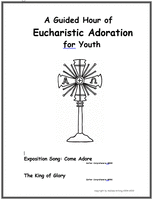
The plans will indicate which prayers/songs are in the booklet for the children to reference. When booklets are not in use, tell the children to put the booklet next to them. This avoids the paper rustling which can be distracting. When it is time for the booklet, I let the children know what page we are in. The prayers/songs go in order. Remind children as needed to place the booklets on the pew so they stay focused on Jesus.
(Booklets are located at the end of each set of plans.)
(Booklets are located at the end of each set of plans.)
Prostration: "Humbling Position"
The children will sit during most of the hour, kneeling or prostrating at other times. The plans will indicate what to do and when to change positions.
Prostrating allows the children to really focus on Jesus and block out distractions. As you will read in the plans, “our God has humbled Himself to come down and be with us in the Blessed Sacrament. We want to do our part to show Him that we love and respect this awesome gift. When we prostrate, we make ourselves very small and humble before Jesus.” (Children of Hope Leader’s Manuel pg. 16) Prostration can be done slightly different depending on your location.
Prostrating allows the children to really focus on Jesus and block out distractions. As you will read in the plans, “our God has humbled Himself to come down and be with us in the Blessed Sacrament. We want to do our part to show Him that we love and respect this awesome gift. When we prostrate, we make ourselves very small and humble before Jesus.” (Children of Hope Leader’s Manuel pg. 16) Prostration can be done slightly different depending on your location.
|
Sitting on Floor If the children are sitting on the floor in your church hall or the floor around the altar in the church: You kneel, put your bottom on your heels, place your hands on your face, and bring your face down to your knees or the floor. Children need to have some space around them in order to prostrate.
|
Sitting in Pews If the children are sitting in the church pews: You kneel on the kneeler. Put your bottom on your seat behind you. Place your hands on your face. Bring your face to the back of the pew in front of you. (Be sure to have everyone put their kneelers down before the hour starts and the kneelers remain down the entire time even when you are not kneeling. This helps eliminate some distractions.)
|
Copyright
All plans, activities, information, etc. on this site are free; however they are only to be used for an individual parish, classroom, and personal use. They may not be published on any websites or other electronic media, or distributed in newsletters, bulletins, or any other form or sold for profit. Reproduction or re-transmission of any materials, in whole or in part, in any manner, is not permitted.
Please do not link directly to any PDF activity or plan using its URL (the unique address for a file that is accessible on the Internet). You are always welcome to link to the specific web page.
Copyright © 2006 - 2023
